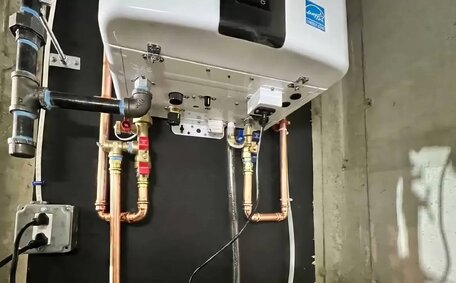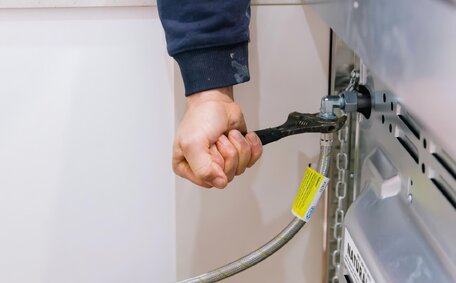Identifying The Gas Meter Outside Your Home
Locating your gas meter is an important first step before attempting to cut off your gas supply. Gas meters in Sydney suburbs are usually located in a dedicated meter box connected to the property’s gas pipes, on the external wall or fence of your property, not far from other utility boxes.
Gas meters, the devices that measure gas consumption, are often grey metal enclosures, roughly 30cm x 50cm, fitted with a gas meter gas pipe and a pressure gauge. This lever, which is the crucial turn tap-style control component of the valve usually, should become perpendicular to the pipe when in the closed position.
The natural gas shutoff valve itself may be a valve you turn tap-style, lever, or wheel handle which needs rotating a quarter turn to shut off the flow.
Ascertain familiarity with the specificities of your individual gas meter, such as its precise spot on your premises, the appearance of the shutoff valve and the correct ways to turn your valve handle to the off position. This knowledge can be crucial in an emergency situation when you need to turn off your gas due to a leak or outage.
If it’s proving challenging to find your gas meter, examine every side your dwelling to learn more about potential locations or consult with a registered gas technician. Your gas provider may also be able to help you if you’re unsure and need to locate the meter, or consider visiting our website for more guidance.
Locating The Gas Shut Off Valve
The supply valve, otherwise known as the gas shut off valve, is located on the inlet gas line of the gas meter. This is the pipe that connects from the gas mains into your metre. The component, which may be a valve tap, lever, or wheel-shaped handle, plays a critical role in the flow control.
Your LPG or natural gas meter shutoff valves are often distinctly marked in bright yellow or red. This colour coding makes them easy to identify. There may also be indicators like "SHUT OFF VALVE" printed on or near the handle.
To operate the gas shut off valve:
- Discover how turn off the supply by determining where the valve is on the inlet supply pipe.
- Take hold of the handle firmly.
- Rotate it a quarter turn (90 degrees) until it sits perpendicular (at a right angle) to the pipe.
This action will switch off the meter, cutting your supply from the mains, akin to shutting the tap on a gas cylinder, to your property. The lever should not sit in line with the pipe when shut off.
Be gentle when you turn your gas supply valve to the off position - refrain from using brute force. If it resists movement, contact your gas company for support.
Valve Designs And How To Operate Them
Gas shutoff valves come in a few common designs, but all operate on the same basic principle of rotating or turning a handle to cut off the gas flow.
Ball Valves
Ball valves, which are more than just a fitting, are named after the spherical ball inside the valve body. Turning the handle rotates this ball to either allow or block gas flow through the valve.
- Turn the handle so it sits perpendicular to the pipe to shut off the gas.
Gate Valves
A gate valve uses a flat metal gate instead of a ball to block the pipe when closed. Turning the handle raises or lowers this gate.
- Turn the handle clockwise to close a gate valve and shut off gas flow.
Lever Valves
Lever handles are a simple and common gas valve design. Rotating the long handle cuts on or off the supply.
- As with other valve types, turn the lever so it crosses the pipe at 90 degrees to stop gas flow.
Street-side gas valves often have a small metal cover over the handle which may need a specialty key to open. Once uncovered though, these larger valves operate the same way.
Always turn off the gas supply your valves gently and deliberately. Never force the handle beyond its normal range of motion, and call a professional if the valve does not turn off easily.
Safety Precautions Before Turning Off Gas
It’s a good idea to embrace safety measures before you try to cut off your gas supply.
Turn off all gas-driven appliances and ensure their appliances’ pilot mechanisms are also switched off within your abode. This includes stoves, ovens, your hot water system, and any gas heating units. Make sure to turn off and understand how to fully extinguish all pilot lights - if unsure, reach out to a licensed gas fitter.
With all gas appliances off, open doors and windows to ventilate the house and lessen the risk of gas leaks. Check if you can smell gas inside before proceeding.
Do not smoke or operate electrical equipment during this process, as gas fumes can lead to an explosion risk.
Should there be a gas leak evidenced by an odour of gas, the hiss of gas escaping, or uncertainty whether all pilot lights are extinguished, escape the premises without hesitation and call the fire brigade on 000.
Engage in the action to turn off gas supply at your main meter only if you are positively sure that all related appliances are fully extinguished, and it’s secure to proceed. If there is any doubt, evacuate and call emergency services instead of taking risks.
Turning off your gas without proper precautions can lead to pilot light outages across your entire home, so use caution.
Step-By-Step Process For Shutting Off The Gas
Adhere to these precautions when you turn gas supply off to your abode:
- Ensure there are no gas appliances inside the home left on, including pilot lights. Open doors and windows to ventilate.
- Confirm it is safe to proceed. Evacuate immediately if you smell gas or are unsure all pilots are off.
- Locate your outdoor gas metre and identify the shutoff valve.
- Take hold of the valve handle firmly and rotate it a quarter turn until perpendicular to the pipe.
- The lever must sit at a right angle to the pipe in the off position.
- Contact your gas supplier or emergency services if there are any issues shutting off the supply or concerns about safety.
Following these six steps correctly will halt the supply your gas flow into your home. With the supply off, do not attempt to turn it back on or relight appliances. Leave that to your gas supplier once the situation has been declared safe.
Understanding Valve Positions And Gas Flow
The position of the gas shutoff valve handle indicates whether gas is flowing or not. When the lever on the inlet pipe is aligned parallel with the pipe, gas is free to flow from the mains into your home’s supply lines and gas appliances.
To cut off the gas flow, you need to turn this handle a quarter rotation (90 degrees). In the off position, the valve lever should sit perpendicular, at a right angle across the inlet pipe. This blocks the pathway and stops gas entering the pipe system.
Should the unmistakable scent of gas permeate your house, you’ll need turn off the main by locating your external gas meter, identifying the shutoff valve on the inlet pipe, and twisting the handle crosswise to the pipe. This simple quarter turn rotation into the off position cuts off the gas supply and makes the situation safe.
The valve should turn smoothly and not require excessive force. Call a professional immediately if you have trouble shutting off the gas or have safety concerns about the leak.
When To Call A Professional Gas Technician
There are important times when you should always contact a licenced professional gas technician rather than attempting to manage the issue yourself:
- If you’re wondering 'do I smell gas’ anywhere in your home
- If you are unable to locate or access your gas metre or shutoff valve
- If you endeavor but find yourself unable to terminate gas supply at your shutoff valve
- If you have turned off the gas but cannot get appliances relit on your own
- For any work on gas appliances like water heaters, cooktops or gas central heating
- If your gas infrastructure sustain any damage from events like floods or earthquakes
During these scenarios, get in touch with the licensed gas professionals at Minchinbury Plumbing on 1300 349 338 or email jobs@minchinburyplumbingservices.com.au without delay. Our licenced gas technicians are available 24/7 to respond to any gas emergency and ensure the safety of you and your home.
Trying to undertake any work on gas systems without proper training can be extremely hazardous. Always put safety first and rely on gas professionals like our team.
Next Steps After Shutting Off The Gas Supply
After safely shutting off the gas supply to your property, there are important next steps to take:
- Do not attempt to turn the gas back on yourself. Leave this to your gas supplier once the situation has been made safe.
- Keep windows and doors open to continue ventilating the property.
- Have a licenced professional gas fitter inspect your gas system and appliances before restoring supply.
- Your technician will need to ensure there are no leaks and relight all pilot lights correctly once gas is turned on.
- Never reconnect gas appliances yourself after an interruption. Improper restoration can cause further issues.
With the gas supply off, seize the chance to service the gas lines to appliances like heaters, cooktops, and your water heater. This preventative maintenance helps avoid problems in future.
In the meantime, avoid using any gas powered devices in the home. Wait for the all clear from your qualified technician before reigniting pilot lights and resuming normal use.
For professional assistance getting your gas supply restored safely, contact the team at Minchinbury Plumbing on 1300 349 338.
Relighting Appliances and Pilot Lights
After the gas supply has been safely turned back on by your gas technician, you’ll need to relight your appliances’ pilot lights before use.
Refer to the user manual or operator instructions for every individual gas appliance to locate the pilot light and follow the proper relighting procedure. Correct lighting methods vary between different appliance makes and models.
If you are unsure on how to safely relight any gas appliance, contact Minchinbury Plumbing on 1300 349 338 to have a licenced technician carry this out. Attempting to DIY with gas comes with potentially hazardous risks if not done properly.
On most domestic gas hot water systems, ovens and cooktops, the pilot light is found at the base of the main burner. Gentle use a barbecue lighter to ignite the gas flow of the pilot, holding down the control dial for around a minute until the flame remains alight when released.
Ensure the pilot flame burns steady and blue without spluttering out. Yellow flames indicate more servicing is needed. Watch appliance operation for 15 minutes to double check all is working safely.
With gas central heating systems, the pilot is separate from the main burner. Carefully follow all manufacturer restarting instructions to get these units relit and running optimally.
If any gas appliances fail to light after several attempts, remain switched off or display irregular burner flames, call our Minchinbury Plumbing team immediately for proper diagnosis and rectification.






